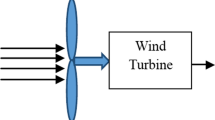Abstract
With the high level of wind power penetration, system executives have an increasing interest in investigating the wind power integration influence on power systems. The doubly fed induction generator (DFIG) is commonly employed in wind power generation systems. In this chapter, we focus on the direct torque and the classic vector control applied to the rotor side converter (RSC) of a grid-connected doubly fed induction generator (DFIG) using a detailed dynamic model under dq reference frame. The two strategies are compared considering many parameters as the rotor currents, the stator power, electromagnetic torque, and rotor flux to ensure the proper operation and to enhance the performance of the DFIG. Both control strategies of our machine are simulated using MATLAB/SIMULINK software package. Finally, the simulations results are displayed and well discussed.
Access this chapter
Tax calculation will be finalised at checkout
Purchases are for personal use only
Similar content being viewed by others
References
Enerdata. (2018). The global energy statistical yearbook. https://yearbook.enerdata.net.
Dehong, X., Frede, B., Wenjie, C., & Nan, Z. (2018). Advanced control of doubly fed induction generator for wind power systems. Wiley.
Fox, B., Leslie, B., Damian, F., Nick, J., David, M., Mark, O., Richard, W., & Olimpo, A. (2014). Wind power integration: Connection and system operational aspects (2nd ed.). Institution of Engineering and Technology.
Kerrouche, K., Mezouar, A., & Belgacem, K. (2013). Decoupled control of doubly fed induction generator by vector control for wind energy conversion system. In Energy procedia (pp. 239–248).
Fei, G., Tao, Z., & Zengping, W. (2012). Comparative study of direct power control with vector control for rotor side converter of DFIG. In 9th IET International Conference on advances in power system control, operation and management (pp. 1–6).
Arnalte, S., Burgos, J. C., & Rodríguez-Amenedo, J. L. (2013). Direct torque control of a doubly-fed induction generator for variable speed wind turbines. Electric Power Components & Systems, 30(2), 199–216.
Li, Y., Hang, L., Li, G., Guo, Y., Zou, Y., Chen, J., Li, J., Jian, Z., & Li, S. (2016). An improved DTC controller for DFIG-based wind generation system. In IEEE 8th International Power Electronics and Motion Control Conference (IPEMC-ECCE Asia) (pp. 1423–1426).
Kumar, A., & GiriBabu, D. (2016). Performance improvement of DFIG fed Wind Energy Conversion system using ANFIS controller. In 2nd International Conference on Advances in Electrical, Electronics, Information, Communication and Bio-Informatics (AEEICB) (pp. 202–206).
Gonzalo, A., Jesus, L., Miguel, R., Luis, M., & Grzegorz, I. (2011). Doubly fed induction machine modeling and control for wind energy generation. Wiley.
Haitham, A., Mariusz, M., & Kamal, A. (2014). Power electronics for renewable energy systems, transportation and industrial applications (1st ed.). Wiley.
Zhaoyang, S., Ping, W., & Pengxian, S. (2014). Research on control strategy of DFIG rotor side converter. In IEEE Conference and Expo Transportation Electrification Asia-Pacific (ITEC Asia-Pacific) (pp. 1–5).
Bin, W., Yongqiang, L., Navid, Z., & Samir, K. (2011). Power conversion and control of wind energy systems. Wiley.
Zhang, Y., Li, Z., Wang, T., Xu, W., & Zhu, J. (2011). Evaluation of a class of improved DTC method applied in DFIG for wind energy applications. In International Conference on electrical machines and systems (pp. 1–6).
Jihène, B., Adel, K., & Mohamed, F. M. (2011). DTC, DPC and Nonlinear Vector Control Strategies Applied to the DFIG Operated at Variable Speed. Journal of Electrical Engineering, 11(3), 1–13.
Xiong, P., & Sun, D. (2016). Backstepping-based DPC strategy of a wind turbine driven DFIG under Normal and harmonic grid voltage. IEEE Transactions on Power Electronics, 31(6), 4216–4225.
Adel, K., Mohamed, F., & M. (2010). Sensorless-adaptive DTC of double star induction motor. Energy Conversion and Management, 51(12), 2878–2892.
Author information
Authors and Affiliations
Editor information
Editors and Affiliations
Appendix
Appendix
1.1 DFIG-WT Parameters
V s (line-line) =690 V, f = 50 Hz, P nom = 2 MW, V r (line-line) = 2070 V, P = 2, u = 1/3, I s = 1070 A, (max slip) s max = 1/3, (rated) T em=12,732 N.m, Fs = 1.9733 Wb, R s = 0.0026 Ω, R r = 0.0029 Ω, L s = Lr = 0.0026 H, L m = 0.0025 H, β = 0, J = 127 kg m2, f = 0.001, σ = 0.0661, V dc = 1150 V, R = 42, ρ = 1.1225, G = 100. K opt = 270,000, ns = synchronous speed = 1500 rev/min, s = 0.000002 s, V w = 12 m/s, (initial slip) = 0.2.
1.2 Parameters of the DTC
-
Ts_DTC = 0.00002 s
-
HT = HF = 1%.
1.3 Parameters of the PI Controllers
-
Kp_id = Kp_iq = 0.5771, Ki_id = Ki_iq = 491.6
-
Kp_n = 10,160, Ki_n = 406,400.
Rights and permissions
Copyright information
© 2022 Springer Nature Switzerland AG
About this paper
Cite this paper
Kouider, K., Bekri, A. (2022). DTC Versus Vector Control Strategies for a Grid Connected DFIG-Based Wind Turbine. In: Elhoseny, M., Yuan, X., Krit, Sd. (eds) Distributed Sensing and Intelligent Systems. Studies in Distributed Intelligence . Springer, Cham. https://doi.org/10.1007/978-3-030-64258-7_62
Download citation
DOI: https://doi.org/10.1007/978-3-030-64258-7_62
Published:
Publisher Name: Springer, Cham
Print ISBN: 978-3-030-64257-0
Online ISBN: 978-3-030-64258-7
eBook Packages: Earth and Environmental ScienceEarth and Environmental Science (R0)




